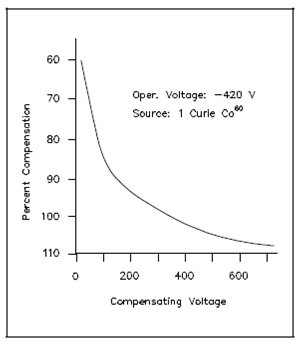Typical Compensation Curve:
The ionization chamber compensation curve, Figure, is a plot of the percent compensation versus compensating voltage. This compensation curve has to be plotted prior to using a compensated ion chamber.
In ideal conditions, compensated ion chambers operate at 100% compensation, and denoted current is because of neutrons. Small modifications in compensating voltage change the percent compensation.
The consequences of operating with an overcompensated or undercompensated chamber are important. The reason of nuclear instrumentation is to detect and measure neutron level that is the direct measure of core power. If the compensating voltage is place too high or overcompensated, a few neutron current, as well as the entire gamma current, is blocked, and denoted power is lower than fact core power. If compensating voltage is set too low, or undercompensated, not the entire gamma current is blocked and denoted power is higher than actual core power. Gamma flux is relatively small compared to neutron flux at high power, and the effects of improper compensation might not be remembered. It is very important, therefore, in which the chamber be properly compensated during reactor startup and shutdown.

Figure: Typical Compensation Curve